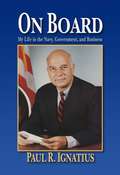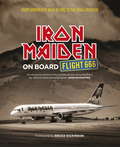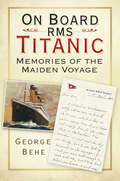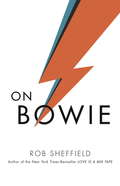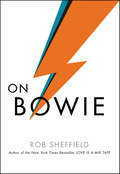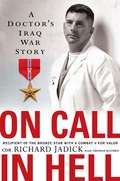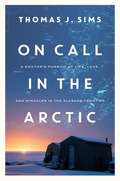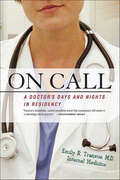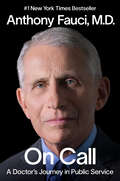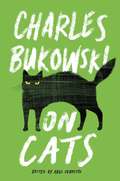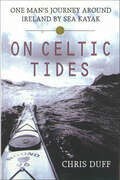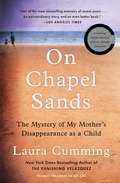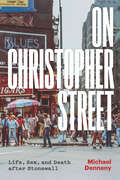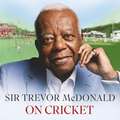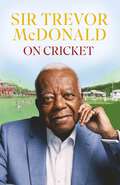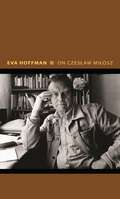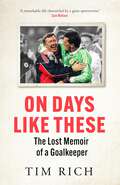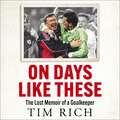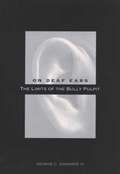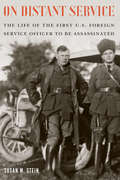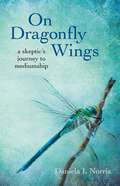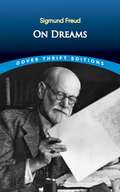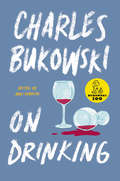- Table View
- List View
On Board
by Paul IgnatiusInsights into important events of the twentieth century are provided in this memoir by a former secretary of the Navy and participant in many of the events he describes. The Great Depression of the 1930s, World War II, the Cold War, the Korean War, and Vietnam are recalled from the author's perspectives, first as a teenager in the 1930s, then as a naval officer in the 1940s, a defense department consultant in the 1950s, and a Pentagon official for eight years in the 1960s. There are new details on Robert McNamara's managerial innovations, the growth of the Army under President Kennedy, and the enormous effort to provide construction, supplies, and ammunition for the Vietnam War. The book includes vivid accounts of McNamara, Clark Clifford, Cyrus Vance, General Creighton Abrams, Admiral Thomas Moorer, and many others, There are high moments when Medals of Honor are awarded, low moments when the USS Pueblo is capture by the North Koreans, and perplexing moments over whether to praise or damn Admiral Hyman Rickover. Other significant events covered are the Pentagon Papers case, the illegal strike of the air traffic controllers, and controversial efforts to deregulate the airlines, the Arab oil embargo of the 1970s, and President Carter's attempt to lessen U.S. dependence on middle-eastern oil. Ignatius also offers intimate glimpses of his family life, including the period when his college-aged children were totally opposed to the Vietnam War, and his Armenian heritage, including memories of his grandfather's poems of freedom that forced him to leave his ancestral home. In the final chapter, Ignatius looks at the civil rights movement and efforts to gain equality for women as events of lasting importance to him.
On Board Flight 666
by Iron Maiden John McMurtrieThe first and only official book from Britain's biggest heavy-metal band.IRON MAIDEN are a global phenomenon. On board their customised Boeing 757 plane named Ed Force One, and piloted by lead singer and airline captain Bruce Dickinson, the band, crew and 12 tonnes of equipment traversed the planet and broke the mould of traditional touring forever by playing concerts in every continent except Antarctica! Setting off in early 2008 on the Somewhere Back In Time world tour, through to the epic Final Frontier tour, Maiden finally played two sold-out shows in their native London. The Final Frontier tour celebrated their 15th and most successful studio album to date, hitting the No.1 spot in at least 28 countries. The band's official photographer John McMurtrie accompanied them on the tours and his unrestricted access allowed him to capture exclusive images and moments both onstage and off, in over 600 spectacular photographs annotated with individual insights and anecdotes.ON BOARD FLIGHT 666 provides an unprecedented insight into one of the most adventurous rock tours ever undertaken; and into what makes this band so special.
On Board RMS Titanic: Memories of the Maiden Voyage
by George Behe‘It would make the stones cry to hear those on board shrieking’ - Daniel Buckley, third-class passenger For the first time, in this moving new book, Titanic’s passengers and crewmen are permitted to tell the story of that lamentable disaster entirely in their own words. Included are letters, postcards, diary entries and memoirs that were written before, during and immediately after the maiden voyage itself. Many of the pre-sailing documents were composed by people who later lost their lives in the sinking and represent the last communications that these people ever had with their friends and loved ones at home. The subsequent letters and postcards give an unparalleled description of the events that occurred during the five days that Titanic was at sea, and the correspondence by survivors after the tragedy describes the horror of the disaster itself and the heartbreak they experienced at the loss of those they loved. This poignant compilation, by Titanic expert George Behe, also contains brief biographies of the passengers and crewmen, victims, as well as survivors, who wrote the documents in question.
On Bowie
by Rob SheffieldOn Bowie is a thoughtful and loving meditation on the life of the late David Bowie that explores his creative legacy and the enduring and mutual connection he enjoyed with his fansInnovative. Pioneering. Brave. Until his death in January 2016, David Bowie created art that not only pushed boundaries, but helped fans understand themselves and view the world from fantastic new perspectives.When the shocking news of his death on January 10, 2016 broke, the outpouring of grief and adulation was immediate and ongoing. Fans around the world and across generations paid homage to this brilliant, innovate, ever-evolving artist who both shaped and embodied our times.In this concise and penetrating book, highly-regarded Rolling Stone critic, bestselling author, and lifelong Bowie fan Rob Sheffield shares his own feelings about the passing of this icon and explains why Bowie's death has elicited such an unprecedented emotional outpouring from so many.
On Bowie
by Rob SheffieldFrom the New York Times bestselling author of Love Is a Mix Tape, a thoughtful and loving meditation on the life of the late David Bowie that explores his creative legacy and the enduring and mutual connection he enjoyed with his fans.Innovative. Pioneering. Brave. Until his death in January 2016, David Bowie created art that not only pushed boundaries, but helped fans understand themselves and view the world from fantastic new perspectives.When the shocking news of his death on January 10, 2016 broke, the outpouring of grief and adulation was immediate and ongoing. Fans around the world and across generations paid homage to this brilliant, innovate, ever evolving artist who both shaped and embodied our times.In this concise and penetrating book, featuring color photographs, highly regarded Rolling Stone critic, bestselling author, and lifelong Bowie fan Rob Sheffield shares his own feelings about the passing of this icon and explains why Bowie’s death has elicited such an unprecedented emotional outpouring from so many lives.
On Call in Hell: A Doctor's Iraq War Story
by Thomas Hayden Richard JadickThe author tells his experiences of working in Fallujah at one of the bloodiest battles in Iraq.
On Call in the Arctic: A Doctor's Pursuit Of Life, Love, And Miracles In The Alaskan Frontier
by Thomas J. SimsAn extraordinary memoir recounting the adventures of a young doctor stationed in the Alaskan bush. The fish-out-of-water stories of Northern Exposure and Doc Martin meet the rough-and-rugged setting of The Discovery Channel’s Alaskan Bush People in Thomas J. Sims’s On Call in the Arctic, where the author relates his incredible experience saving lives in one of the most remote outposts in North America. Imagine a young doctor, trained in the latest medical knowledge and state-of-the-art equipment, suddenly transported back to one of the world’s most isolated and unforgiving environments—Nome, Alaska. Dr. Sims’ plans to become a pediatric surgeon drastically changed when, on the eve of being drafted into the Army to serve as a M.A.S.H. surgeon in Vietnam, he was offered a commission in the U.S. Public Health for assignment in Anchorage, Alaska. In Anchorage, Dr. Sims was scheduled to act as Chief of Pediatrics at the Alaska Native Medical Center. Life changed, along with his military orders, when he learned he was being transferred from Anchorage to work as the only physician in Nome. There, he would have the awesome responsibility of rendering medical care under archaic conditions to the population of this frontier town plus thirteen Eskimo villages in the surrounding Norton Sound area. And he would do it alone with little help and support. All the while, he was pegged as both an “outsider” and an employee of the much-derided federal government. In order to do his job, Dr. Sims had to overcome racism, cultural prejudices, and hostility from those who would like to see him sent packing. On Call in the Arctic reveals the thrills and the terrors of frontier medicine, where Dr. Sims must rely upon his instincts, improvise, and persevere against all odds in order to help his patients on the icy shores of the Bering Sea.
On Call: A Doctor's Days and Nights in Residency
by Emily R. TransueOn Call begins with a newly-minted doctor checking in for her first day of residency--wearing the long white coat of an MD and being called "Doctor" for the first time. Having studied at Yale and Dartmouth, Dr. Emily Transue arrives in Seattle to start her internship in Internal Medicine just after graduating from medical school. This series of loosely interconnected scenes from the author's medical training concludes her residency three years later.During her first week as a student on the medical wards, Dr. Transue watched someone come into the emergency room in cardiac arrest and die. Nothing like this had ever happened to her before-it was a long way from books and labs. So she began to record her experiences as she gained confidence putting her book knowledge to work.The stories focus on the patients Dr. Transue encountered in the hospital, ER and clinic; some are funny and others tragic. They range in scope from brief interactions in the clinic to prolonged relationships during hospitalization. There is a man newly diagnosed with lung cancer who is lyrical about his life on a sunny island far away, and a woman, just released from a breathing machine after nearly dying, who sits up and demands a cup of coffee.Though the book has a great deal of medical content, the focus is more on the stories of the patients' lives and illnesses and the relationships that developed between the patients and the author, and the way both parties grew in the course of these experiences.Along the way, the book describes the life of a resident physician and reflects on the way the medical system treats both its patients and doctors. On Call provides a window into the experience of patients at critical junctures in life and into the author's own experience as a new member of the medical profession.
On Call: A Doctor's Journey in Public Service
by Anthony FauciThe memoir by the doctor who became a beacon of hope for millions through the COVID pandemic, and whose six-decade career in high-level public service put him in the room with seven presidents <P><P> Anthony Fauci is arguably the most famous – and most revered – doctor in the world today. His role guiding America sanely and calmly through Covid (and through the torrents of Trump) earned him the trust of millions during one of the most terrifying periods in modern American history, but this was only the most recent of the global epidemics in which Dr. Fauci played a major role. His crucial role in researching HIV and bringing AIDS into sympathetic public view and his leadership in navigating the Ebola, SARS, West Nile, and anthrax crises, make him truly an American hero. <P><P> His memoir reaches back to his boyhood in Brooklyn, New York, and carries through decades of caring for critically ill patients, navigating the whirlpools of Washington politics, and behind-the-scenes advising and negotiating with seven presidents on key issues from global AIDS relief to infectious disease preparedness at home. ON CALL will be an inspiration for readers who admire and are grateful to him and for those who want to emulate him in public service. He is the embodiment of “speaking truth to power,” with dignity and results. <p> <b>New York Times Bestseller</b>
On Cats
by Charles BukowskiA raw and tenderly funny look at the human-cat relationship, from one of our most treasured, iconic writersFelines touched a vulnerable spot in the unfathomable soul of Charles Bukowski, the Dirty Old Man of American letters. For the writer, there was something majestic and elemental about these inscrutable creatures, whose searing gaze could penetrate deep into our beings. Bukowski considered cats to be unique forces of nature, elusive emissaries of beauty and love.On Cats offers Bukowski's musings on these beloved animals and their toughness and resiliency. He honors them as fighters, hunters, survivors who command awe and respect as they grip tightly onto the world around them: "A cat is only ITSELF, representative of the strong forces of life that won't let go."Funny and moving, Bukowski's On Cats brings together the acclaimed writer's reflections on these animals he so admired. Bukowski's cats are fierce and demanding--he captures them stalking their prey; crawling across his typewritten pages; waking him up with claws across the face. But they are also affectionate and giving, sources of inspiration and gentle, insistent care.Poignant yet free of treacle, On Cats is an illuminating portrait of this one-of-a-kind artist and his unique view of the world, witnessed through his relationship with the animals he considered among his most profound teachers.
On Celtic Tides: One Man's Journey Around Ireland by Sea Kayak
by Chris Duff“Duff’s fascinating account of his twelve hundred-mile journey around the Irish coast . . . is a story of discovery, of courage and perseverance, and life.” —Irish VoiceA sea kayak battles the freezing Irish waters as the morning sun rises out of the countryside. On the western horizon is the pinnacle of Skellig Michael—700 feet of vertical rock rising out of exploding seas. Somewhere on the isolated island are sixth-century monastic ruins where the light of civilization was kept burning during the Dark Ages by early Christian Irish monks. Puffins surface a few yards from the boat, as hundreds of gannets wheel overhead on six foot wing spans. The ocean rises violently and tosses paddler and boat as if they were discarded flotsam. This is just one day of Chris Duff’s incredible three-month journey.“I recommend you take a ride at wave level with Chris Duff as he fights his way through ferocious seas, then brings you closer to a truly enchanted isle.” —David Hays, coauthor of the New York Times bestseller My Old Man and the Sea“His attention to detail and the vividness of his descriptions place the reader in the kayak with him. We feel the heaviness of the dense fog, each violent wave, the aching muscles as he gingerly navigates the treacherous water, and the warmth of the morning sun as it beckons further travel. Best of all, he offers us a peek into the hearts of the Irish people.” —The Oakland Press“Here is a fine, old-fashioned travelogue. Duff sallies forth and returns with a magical story for those left behind.” —Kirkus Reviews
On Chapel Sands: The Mystery of My Mother's Disappearance as a Child
by Laura CummingNOMINATED FOR THE 2019 NATIONAL BOOK CRITICS CIRCLE AWARD FOR AUTOBIOGRAPHY ONE OF NPR'S BEST BOOKS OF THE YEAR SHORTLISTED FOR THE BAILLIE GIFFORD PRIZE FOR NONFICTION SHORTLISTED FOR THE RATHBONES FOLIO PRIZE LONGLISTED FOR THE RSL ONDAATJE PRIZE The acclaimed New York Times bestselling author of The Vanishing Velazquez shares a riveting true story &“with as many twists and turns as any mystery&” (Los Angeles Times) describing her mother&’s mysterious kidnapping as a toddler in a small English coastal village—&“an incredible and incredibly unusual book about family secrets&” (Nick Hornby, The Believer).In the fall of 1929, when Laura Cumming&’s mother was three years old, she was kidnapped from a beach on the Lincolnshire coast of England. There were no screams when she was taken, suggesting the culprit was someone familiar to her, and when she turned up again in a nearby village several days later, she was happy and in perfect health. No one was ever accused of a crime. The incident quickly faded from her memory, and her parents never discussed it. To the contrary, they deliberately hid it from her, and she did not learn of it for half a century. This was not the only secret her parents kept from her. For many years, while raising her in draconian isolation and protectiveness, they also hid the fact that she&’d been adopted, and that shortly after the kidnapping, her name was changed from Grace to Betty. &“Both page-turning and richly absorbing&” (The Providence Journal), On Chapel Sands (originally titled Five Days Gone) unspools the tale of Cumming&’s mother&’s life and unravels the multiple mysteries at its core. Using photographs from the time, historical documents, and works of art, Cumming investigates this case of stolen identity with the toolset of a detective and the unique intimacy of a daughter trying to understand her family&’s past and its legacies. &“Brilliant&” (The Guardian) and &“a story told with such depth of feeling and observation and such lyrical writing I couldn&’t put it down&” (Anna Quindlen), On Chapel Sands is a masterful blend of memoir and history, an extraordinary personal narrative unlike any other.
On Christopher Street: Life, Sex, and Death after Stonewall
by Michael DennenyThrough the eyes of publishing icon Michael Denneny, this cultural autobiography traces the evolution of the US’s queer community in the three decades post-Stonewall. The Stonewall Riots of 1969 and the AIDS crisis of the 1980s have been captured in minute detail, and rightly memorialized in books, on tv, and in film as pivotal and powerful moments in queer history. Yet what about the moments in between—the tumultuous decade post-Stonewall when the queer community’s vitality and creativity exploded across the country, even as the AIDS crisis emerged? Michael Denneny was there for it all. As a founder and editor of the wildly influential magazine Christopher Street and later as the first openly gay editor at a major publishing house, Denneny critically shaped publishing around gay subjects in the 1970s and beyond. At St. Martin’s Press, he acquired a slew of landmark titles by gay authors—many for his groundbreaking Stonewall Inn Editions—propelling queer voices into the mainstream cultural conversation. On Christopher Street is Denneny’s time machine, going back to that heady period to lay out the unfolding geographies and storylines of gay lives and capturing the raw immediacy of his and his contemporaries’ daily lives as gay people in America. Through forty-one micro-chapters, he uses his journal writings, articles, interviews, and more from the 1970s and ‘80s to illuminate the twists and turns of a period of incomparable cultural ferment. One of the few surviving voices of his generation, Denneny transports us back in time to share those vibrant in-between moments in gay lives—the joy, sorrow, ecstasy, and energy—across three decades of queer history.
On Cricket
by Sir Trevor McDonaldSir Trevor McDonald is one of Britain's most celebrated broadcasters and his devotion for cricket is almost as well-known as his legendary professional achievements.In this inspirational memoir, On Cricket, Sir Trevor explores his childhood in the Caribbean and celebrates his life-long love of the sport that followed him no matter where in the world his illustrious journalistic career would take him.Sir Trevor offers a wide-ranging commentary on cricket as a common language between England, the West Indies and beyond - a sense of belonging that knows no borders - and celebrates cricket as an engine of national identity and an essential feature of daily life and community.An exceptional storyteller and commentator, On Cricket is a love letter to the sport and a study of Sir Trevor's oldest and most consistent passion: watching, debating and playing the gentleman's game.
On Cricket
by Sir Trevor McDonaldSir Trevor McDonald is one of Britain's most celebrated broadcasters and his devotion for cricket is almost as well-known as his legendary professional achievements.In this inspirational memoir, On Cricket, Sir Trevor explores his childhood in the Caribbean and celebrates his life-long love of the sport that followed him no matter where in the world his illustrious journalistic career would take him.Sir Trevor offers a wide-ranging commentary on cricket as a common language between England, the West Indies and beyond - a sense of belonging that knows no borders - and celebrates cricket as an engine of national identity and an essential feature of daily life and community.An exceptional storyteller and commentator, On Cricket is a love letter to the sport and a study of Sir Trevor's oldest and most consistent passion: watching, debating and playing the gentleman's game.
On Czeslaw Milosz: Visions from the Other Europe (Writers on Writers #14)
by Eva HoffmanA compelling personal introduction to the life and work of Nobel Prize–winning writer Czesław Miłosz from his fellow Polish exile and acclaimed writer Eva HoffmanCzesław Miłosz (1911–2004) was a giant of twentieth-century literature, not least because he lived through and wrote about many of the most extreme events of that extreme century, from the world wars and the Holocaust to the Cold War. Over a seven-decade career, he produced an important body of poetry, fiction, and nonfiction, including classics such as The Captive Mind, a reflection on the hypnotic power of ideology, and Native Realm, a memoir. In this book, Eva Hoffman, like Miłosz a Polish-born writer who immigrated to the West, presents an eloquent personal portrait of the life and work of her illustrious fellow exile.Miłosz experienced the horrors of World War II in Warsaw—the very epicenter of the inferno—and witnessed the unfolding of the Holocaust from up close. After the war, he lived as a permanent exile—from Poland, communism, and mainstream American culture. Hoffman explores how exile, historical disasters, and Miłosz’s origins in Eastern Europe shaped his vision, and she occasionally compares her own postwar trajectory with Miłosz’s to show how the question of “the Other Europe” is still with us today. She also examines his later turn to the poetry of memory and loss, driven by the need to remember and honor his many friends and others killed in the Holocaust.Combining incisive personal and critical insights, On Czesław Miłosz captures the essence of the life and work of a great poet and writer.
On Days Like These: The Lost Memoir of a Goalkeeper
by Tim Rich'Emotional, insightful, beautifully written. A story of making saves and being saved. The best football book I have read this year.' Henry WinterJoe Sealey was watching his son play for Manchester United's Under-14s when a man came up to him and said: 'I've got your dad's book.'Joe's father, Les, had been Manchester United's goalkeeper but had died of a heart attack in 2001 at the age of 43. His death tormented Joe, who had been West Ham's reserve keeper. Joe had given up on football, slipping into an alcohol and drug addiction that almost killed him. He had forgotten what his father's voice sounded like. Now, here it was in form of a Tupperware box full of cassette tapes.The centrepiece of the tapes is the most important game in the modern history of Manchester United, the 1990 FA Cup final. After three barren years at Old Trafford, Alex Ferguson was on the brink of dismissal. There was just the FA Cup final left. He knew that, if it was lost, he would almost certainly be sacked. After the first game against Crystal Palace was drawn 3-3, he dropped his goalkeeper, Jim Leighton, who had been with Ferguson for most of his managerial career, and replaced him with Sealey, who had played just two matches in a year.The replay was won and by the time Sealey left Old Trafford in 1994, Manchester United had become the dominant force in English football.On Days Like These is an intimate portrait of a club dragged from the brink. It is also the story of Joe Sealey's journey to the edge and back. Many years later Joe met Ferguson. 'Your father saved my career,' Ferguson said. 'And you saved his,' was the reply. On Days Like These is a story of two rescues.'Brings alive early 90s #MUFC & the mad genius of Ferguson' Sam Wallace
On Days Like These: The Lost Memoir of a Goalkeeper
by Tim Rich'Emotional, insightful, beautifully written. A story of making saves and being saved. The best football book I have read this year.' Henry WinterJoe Sealey was watching his son play for Manchester United's Under-14s when a man came up to him and said: 'I've got your dad's book.'Joe's father, Les, had been Manchester United's goalkeeper but had died of a heart attack in 2001 at the age of 43. His death tormented Joe, who had been West Ham's reserve keeper. Joe had given up on football, slipping into an alcohol and drug addiction that almost killed him. He had forgotten what his father's voice sounded like. Now, here it was in form of a Tupperware box full of cassette tapes.The centrepiece of the tapes is the most important game in the modern history of Manchester United, the 1990 FA Cup final. After three barren years at Old Trafford, Alex Ferguson was on the brink of dismissal. There was just the FA Cup final left. He knew that, if it was lost, he would almost certainly be sacked. After the first game against Crystal Palace was drawn 3-3, he dropped his goalkeeper, Jim Leighton, who had been with Ferguson for most of his managerial career, and replaced him with Sealey, who had played just two matches in a year.The replay was won and by the time Sealey left Old Trafford in 1994, Manchester United had become the dominant force in English football.On Days Like These is an intimate portrait of a club dragged from the brink. It is also the story of Joe Sealey's journey to the edge and back. Many years later Joe met Ferguson. 'Your father saved my career,' Ferguson said. 'And you saved his,' was the reply. On Days Like These is a story of two rescues.'Brings alive early 90s #MUFC & the mad genius of Ferguson' Sam Wallace
On Days Like These: The Lost Memoir of a Goalkeeper
by Tim Rich'Emotional, insightful, beautifully written. A story of making saves and being saved. The best football book I have read this year.' Henry WinterJoe Sealey was watching his son play for Manchester United's Under-14s when a man came up to him and said: 'I've got your dad's book.'Joe's father, Les, had been Manchester United's goalkeeper but had died of a heart attack in 2001 at the age of 43. His death tormented Joe, who had been West Ham's reserve keeper. Joe had given up on football, slipping into an alcohol and drug addiction that almost killed him. He had forgotten what his father's voice sounded like. Now, here it was in form of a Tupperware box full of cassette tapes.The centrepiece of the tapes is the most important game in the modern history of Manchester United, the 1990 FA Cup final. After three barren years at Old Trafford, Alex Ferguson was on the brink of dismissal. There was just the FA Cup final left. He knew that, if it was lost, he would almost certainly be sacked. After the first game against Crystal Palace was drawn 3-3, he dropped his goalkeeper, Jim Leighton, who had been with Ferguson for most of his managerial career, and replaced him with Sealey, who had played just two matches in a year.The replay was won and by the time Sealey left Old Trafford in 1994, Manchester United had become the dominant force in English football.On Days Like These is an intimate portrait of a club dragged from the brink. It is also the story of Joe Sealey's journey to the edge and back. Many years later Joe met Ferguson. 'Your father saved my career,' Ferguson said. 'And you saved his,' was the reply. On Days Like These is a story of two rescues.'Brings alive early 90s #MUFC & the mad genius of Ferguson' Sam Wallace
On Deaf Ears: The Limits of the Bully Pulpit
by George C. EdwardsAmerican presidents often engage in intensive campaigns to obtain public support for their policy initiatives. This core strategy for governing is based on the premise that if presidents are skilled enough to exploit the "bully pulpit," they can successfully persuade or even mobilize public opinion on behalf of their legislative goals. In this book, George Edwards analyzes the results of hundreds of public opinion polls from recent presidencies to assess the success of these efforts. Surprisingly, he finds that presidents typically are not able to change public opinion; even great communicators usually fail to obtain the public's support for their high-priority initiatives. Focusing on presidents' personae, their messages, and the American public, he explains why presidents are often unable to move public opinion and suggests that their efforts to do so may be counterproductive. Edwards argues that shoring up previously existing support is the principal benefit of going public and that "staying private"--negotiating quietly with elites-may often be more conducive to a president's legislative success.
On Different Roads: An Autobiography
by Geraldine LawhornA true story of an incredible woman who was not about to be held back by the challenges of becoming blind and deaf before she completed high school. Not only does Geraldine Lawhorn live a full life, but she also continues to help others.
On Distant Service: The Life of the First U.S. Foreign Service Officer to Be Assassinated
by Susan M. SteinOn July 18, 1924, a mob in Tehran killed U.S. foreign service officer Robert Whitney Imbrie. His violent death, the first political murder in the history of the service, outraged the American people. Though Imbrie&’s loss briefly made him a cause célèbre, subsequent events quickly obscured his extraordinary life and career. Susan M. Stein tells the story of a figure steeped in adventure and history. Imbrie rejected a legal career to volunteer as an ambulance driver during World War I and joined the State Department when the United States entered the war. Assigned to Russia, he witnessed the October Revolution, fled ahead of a Bolshevik arrest order, and continued to track communist activity in Turkey even as the country&’s war of independence unfolded around him. His fateful assignment to Persia led to his death at age forty-one and set off political repercussions that cloud relations between the United States and Iran to this day. Drawing on a wealth of untapped materials, On Distant Service returns readers to an era when dash and diplomacy went hand-in-hand.
On Dragonfly Wings: A Skeptic's Journey to Mediumship
by Daniela I. NorrisOn Dragonfly Wings -- a Skeptic's Journey to Mediumship, is a candid and personal search for the meaning of life, of death and of grief. It aims to give hope to those who have lost a loved one and to those who are about to pass beyond -- hope that this is not an end. Written for lay people, rather than experienced spiritualists or mediums, and for anyone who is curious about exploring further, it provides practical tools to help readers find their own spiritual truth and path.
On Dreams (Dover Thrift Editions Ser.)
by Sigmund Freud M. D. EderAmong the first of Sigmund Freud's many contributions to psychology and psychoanalysis was The Interpretation of Dreams, published in 1900, and considered his greatest work -- even by Freud himself. Aware, however, that it was a long and difficult book, he resolved to compile a more concise and accessible version of his ideas on the interpretation of dreams. That shorter work is reprinted here. Since its publication, generations of readers and students have turned to this volume for an authoritative and coherent account of Freud's theory of dreams as distorted wish fulfillment.After contrasting the scientific and popular views of dreams, Freud illustrates the ways in which dreams can be shown to have been influenced by the activities or thoughts of the preceding day. He considers the effect on dreams of such mental mechanisms as condensation, dramatization, displacement, and regard for intelligibility. In addition, the author offers perceptive insights into repression, the three classes of dreams, and censorship within the dream.Students and psychologists will welcome this inexpensive edition of an always-relevant work by the father of modern psychoanalysis. This volume will also appeal to anyone interested in dreams of the workings of the unconscious mind.
On Drinking
by Charles BukowskiThe definitive collection of works on a subject that inspired and haunted Charles Bukowski for his entire life: alcohol Charles Bukowski turns to the bottle in this revelatory collection of poetry and prose that includes some of the writer’s best and most lasting work. A self-proclaimed “dirty old man,” Bukowski used alcohol as muse and as fuel, a conflicted relationship responsible for some of his darkest moments as well as some of his most joyful and inspired. In On Drinking, Bukowski expert Abel Debritto has collected the writer’s most profound, funny, and memorable work on his ups and downs with the hard stuff—a topic that allowed Bukowski to explore some of life’s most pressing questions. Through drink, Bukowski is able to be alone, to be with people, to be a poet, a lover, and a friend—though often at great cost. As Bukowski writes in a poem simply titled “Drinking,”: “for me/it was or/is/a manner of/dying/with boots on/and gun/smoking and a/symphony music background.” On Drinking is a powerful testament to the pleasures and miseries of a life in drink, and a window into the soul of one of our most beloved and enduring writers.
